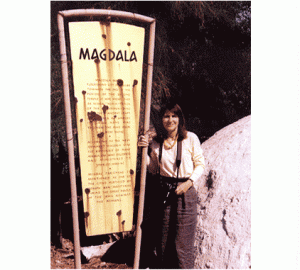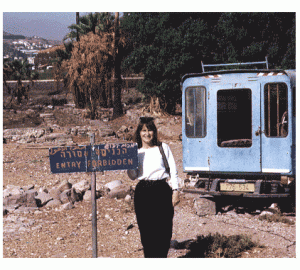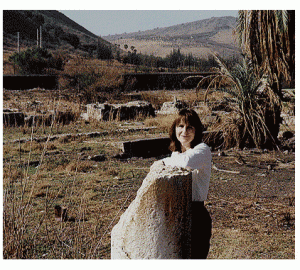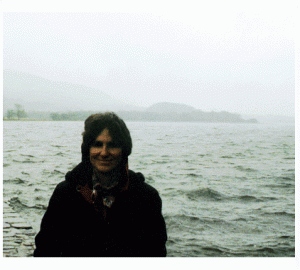Most of my adventures seem to center around either trying to do something forbidden (either by people or by the weather), or meeting strange characters at the site.
I’ve never sought help in gaining entry to a site by writing ahead or trying to contact some professional guardian. Maybe it just seems too packaged that way, and that’s why I stubbornly avoid doing it. The advantage to this is that you can see the site incognito. The down side, of course, is that you might not be able to see it at all!

I spent some time in Israel doing research for MARY CALLED MAGDALENE; Mary Magdalene takes her name from Magdala, a fishing town on the west side of the Sea of Galilee. The ancient site of Magdala was excavated in the 1970s but in the passing years had become overgrown again, and it was never part of the tourist track. It proved as elusive to find as the character of Mary herself. A large, yellow, bullet-pockmarked sign along the highway proclaims that the town is there below, but it is invisible.
No road leads to it, and inquiries at other buildings along the way drew blank looks. Finally I turned off into a citrus grove and was directed along the shoreline, past a tacky water park. It was just sunset and although I could glimpse the site, it was encircled with a chain fence and locked.

A year later I was back during the daytime, only to find it locked again. Then a rattletrap truck drove down a dirt road leading up to the locked gates; the owners were returning, briefly. They allowed me in, although they could not understand what it was I wanted, as we did not speak one another’s language. It was a very peaceful site, with old trees by the abandoned waterfront, donkeys tethered underneath, and the town—excavated by the Franciscan Institute—open and waiting, its squares and streets empty, except of ghosts. The owners let me stay as long as I liked, drinking in the feel of the place. Had I not been there at the moment the truck came along, I never would have gained entrance to the place where Mary Magdalene grew up, and it would have been difficult to re-imagine her world. The entire rest of the time I was in the area, I never saw the owners again or saw anyone at the site; it remained locked up.

When I came to Alexandria to visit the site of Cleopatra’s palace, I found that area is now occupied by an Egyptian military post. Not only was I not allowed to go into it, the soldiers forbade any photos to be taken of the area. Now I did not travel two thousand years in time and six thousand miles on earth to take no for an answer. So my husband and I used the decoy method of distracting their attention, pretending to take photos of the harbor, and then swung the camera back to catch the peninsula where Cleopatra had walked and reigned.

At one time no photography was allowed inside Holyrood Palace in Edinburgh, where so many tumultuous things happened to Mary Queen of Scots. In Mary’s bedroom, the place where her secretary Riccio was stabbed, it was vital to know the exact dimensions and how the supper-alcove related to the rest of the room, since so many details of the murder hinge on the logistics. I was able to hide a spy-type camera in my coat pocket and fall behind the tour group in the key rooms and take the necessary photographs, coughing to cover up the telltale sound of the camera shutter.
In the category of interesting people, when I visited Bolton Castle in northern England, one of the first castles where Mary Queen of Scots was imprisoned, the young man overseeing the place turned out to be a descendent of the Queen’s last jailor, Sir Amyas Paulet. The events involving Mary and his ancestor may have been over four hundred years old, but not to him. He was incensed that his ancestor had been besmirched by sympathizers for the Scots queen, been made to seem cruel, when he was absolutely no such thing! I tried to assure him that I would be open-minded about the man, and that after all his ancestor had proved his character once and for all when he refused Queen Elizabeth’s ‘hints’ to murder the Scots Queen, but he was still disgruntled. I promised to send him a copy of the book and not to trash his ancestor. I sent him a copy but never heard from him, so I don’t know if he still felt his ancestor had been insulted.

Due to the (in)famous Scottish weather, it can be difficult to get out to sites if you must cross open water. Mary Queen of Scots had two important island sojourns in her life, both involving escapes and chases. One of those was Inchmahome, a tiny island in a loch that was storm-tossed the day I tried to go there. As a National Heritage site it was supposed to be open, but the Scots boatmen were leery of setting out—until I told them of my project about Mary Queen of Scots. Then they were willing to risk it! She still has that effect on people.
